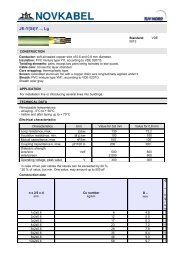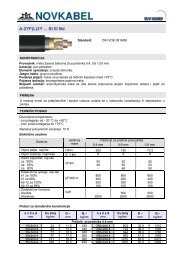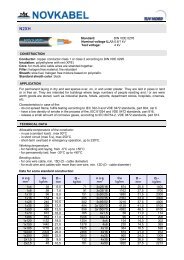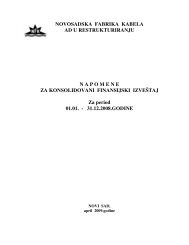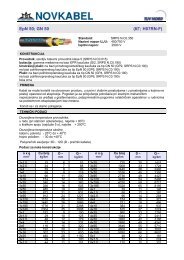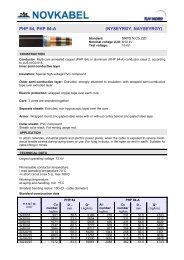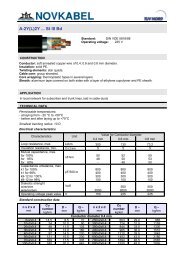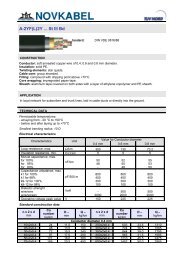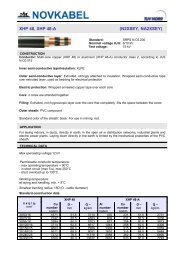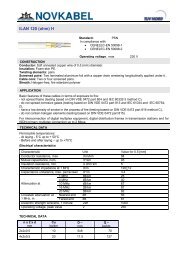- Page 1 and 2:
CABLES ANDWIRESNovi Sad, Republic o
- Page 3 and 4:
ContentPOWER CABLES................
- Page 5 and 6:
Company ProfileAbout usThe Cable Fa
- Page 7 and 8:
[Type text]PP 00, PP 00-AВВГ, А
- Page 9 and 10:
PP 40, PP 40-AВВГЭ, АВВГЭ;
- Page 13 and 14:
PP 44; PP 44-ANYRGY, NAYRGYPower ca
- Page 17 and 18:
XP 00, XP 00-AN2XY, NA2XYPower cabl
- Page 19 and 20:
XP 41, XP 41-AПвБбШв, АПв
- Page 21 and 22:
XP 44; XP 44-AN2XRGY, NA2XRGYPower
- Page 23 and 24:
XP 45, XP 45-AN2XFGY, NA2XFGYPower
- Page 25 and 26:
PHP 48, PHP 48-AВВГЭ, АВВГ
- Page 27 and 28:
PHP 81, PHP 81-ANYSEYBY, NAYSEYBYMe
- Page 29 and 30:
PHP 85, PHP 85-ANYSEYFGY, NAYSEYFGY
- Page 31 and 32:
XHP 48, XHP 48-AN2XSEY, NA2XSEYMedi
- Page 33 and 34:
XHEh 91, XHEh 91-AMedium voltage ca
- Page 35 and 36:
XHP 84, XHP 84-AN2XSYRGY, NA2XSYRGY
- Page 37 and 38:
0033
- Page 39 and 40:
PH07V-U, H07V-RInstallation cable w
- Page 41 and 42:
PP/RInstallation cable with PVCStan
- Page 43 and 44:
P/FH07V-KFlexible installation cabl
- Page 45 and 46:
PP/LH03VV-FFlexible cable with PVCS
- Page 47 and 48:
PP/JZFlexible cable with electrical
- Page 49 and 50:
045
- Page 51 and 52:
PP 00NYYSignal cable with PVCStanda
- Page 53 and 54:
PP 44NYRGYSignal cable with PVCStan
- Page 55 and 56:
XP 00N2XYSignal cable with XLPE ins
- Page 57 and 58:
NYSLYCYFlexible signal cable with e
- Page 59 and 60:
NYSLYCYÖH05VVC4V5-K, NSKKE/FFlexib
- Page 61 and 62:
SPZRailway station signal safety ca
- Page 63 and 64:
H01N2-D; ZN/SFlexible welding cable
- Page 65 and 66:
H05RN-FFlexible rubber cableStandar
- Page 67 and 68:
NFK TESFlexible cable for submersib
- Page 69 and 70:
NSGAöu, NSGAFöuRailway cables wit
- Page 71 and 72:
ППСРВМRailway cable with rubb
- Page 73 and 74:
NGFLGöuFlat rubber cableStandard:
- Page 75 and 76:
NFK EpTN, NSHTöuEspecially flexibl
- Page 77 and 78:
NFK SiSi/JFlexible cable for higher
- Page 79 and 80:
NFK EpN 50Flexible mining cable wit
- Page 81 and 82:
EpN 53NSSHöu .../3EFlexible low vo
- Page 83 and 84:
EpN 58Very flexible low voltage min
- Page 85 and 86:
EpN 61 NSSHCGEöu .../3Flexible low
- Page 87 and 88:
EpN 63NSSHCGEöu .../KON+St+ϋlFlex
- Page 89 and 90:
EpN 65NTSCGECWöu ... KONFlexible m
- Page 91 and 92:
EpN 78 NTSCGEWöu ... /3Flexible me
- Page 93 and 94:
MGGPower shipboard cableStandard: D
- Page 95 and 96:
TK59 DSL (30)... M, TK59 DSL (30)..
- Page 97 and 98:
2YYLeading insulated conductorStand
- Page 99 and 100:
J-Y(St)Y ...Installation cableStand
- Page 101 and 102:
TI 20Telephone installation cableSt
- Page 103 and 104:
TC44 ... E, TC44 ... GESwitchboard
- Page 105 and 106:
TZ44 ... E, TZ44 ... GELow-frequenc
- Page 107 and 108:
TK33 USelf-supporting low-frequency
- Page 109 and 110:
TK59...M, TK59...GMFilled low-frequ
- Page 111 and 112:
TK59...MR , TK59...GMRFilled low-fr
- Page 113 and 114:
TPP EPLow-frequency telephone subsc
- Page 115 and 116:
A-2Y(L)2Y ...St III BdLow-frequency
- Page 117 and 118:
TD 39 U-P, TD 59 U-PSelf-supporting
- Page 119 and 120:
ТБТЗБLow-frequency subscriber
- Page 121 and 122:
S-YYSignal cableStandard: VDE 0813C
- Page 123 and 124:
TO SM O3 nxIIx0,4x3,5xCMANOptical c
- Page 125 and 126:
121
- Page 127 and 128:
YInstallation insulated conductorSt
- Page 129 and 130:
6YEquipment wire FEP insulatedStand
- Page 131 and 132:
LiY; LifY;LiY-T;LifY-TFlexible inte
- Page 133 and 134:
Li7YFlexible ETFE insulated conduct
- Page 135 and 136:
LiYCY; So-LiYCYCables for electroni
- Page 137 and 138:
133
- Page 139 and 140:
NAUK 001,002,003Cables for internal
- Page 141 and 142:
NAUK 102Flexible microphone star qu
- Page 143 and 144:
NAUK 300Cables for speaker-phonesSt
- Page 145 and 146:
NAUK 901, 904Cables for loudspeaker
- Page 147 and 148:
LiHHHalogen free cable for electron
- Page 149 and 150:
H05ZHalogen free cablesStandard: DI
- Page 151 and 152:
H07ZZ-FHalogen free flame retardant
- Page 153 and 154:
N2XHHalogen free cables with improv
- Page 155 and 156:
N2XSHMedium voltage halogen free ca
- Page 157 and 158:
NHXHXHalogen free cable with improv
- Page 159 and 160:
NHXCHXHalogen free cable with elect
- Page 161 and 162:
LiHXHXFlexible halogen free cableSt
- Page 163 and 164:
LiHXCHXFlexible halogen free cable
- Page 165 and 166:
ILAN 120 (ohm) HHalogen free instal
- Page 167 and 168:
J-2Y(St)HHalogen free cable for tra
- Page 169 and 170:
conductor 0,4 [mm]conductor 0,6 [mm
- Page 171 and 172:
THITelephone halogen free installat
- Page 173 and 174:
THNJ-HHHalogen free installation ca
- Page 175 and 176:
THNE FE 20JE-H(St)H FE20Halogen fre
- Page 177 and 178:
MGHHalogen free power shipboard cab
- Page 179 and 180:
175
- Page 181 and 182:
RG 50 ΩCoaxial cablesStandard: MIL
- Page 183 and 184:
179
- Page 185 and 186:
ALUMOVELD CONDUCTORSAlumoveld condu
- Page 187 and 188:
ALUMINIUM CONDUCTORSAluminium condu
- Page 189 and 190:
CrosssectionNumber x diameter wirea
- Page 191 and 192: PROTECTIVE ROPES FOR TRANSMISSION L
- Page 193 and 194: X00/AInsulated overhead lineStandar
- Page 195 and 196: СИП 3Insulated overhead lineStan
- Page 197 and 198: 193
- Page 199 and 200: WIRE OF ALUMINIUMRound wire for dif
- Page 201 and 202: TINNED COPPER WIRERound tinned copp
- Page 203 and 204: COPPER CONDUCTORSStranded copper an
- Page 205 and 206: BRAIDED COPPER ROPESRound flexible
- Page 207 and 208: FLAT BRAIDSStranded flat copper and
- Page 209 and 210: WIRE FOR EROSIMATEBrass wire with a
- Page 211 and 212: 207
- Page 213 and 214: Properties of materials used for ca
- Page 215 and 216: Halogen free fire retardant cables
- Page 217 and 218: [Type text]Conductor resistanceTabl
- Page 219 and 220: Core markingThe cores of power cabl
- Page 221 and 222: Number of pairs Core A Core B15 37
- Page 223 and 224: CURRENT LOADCurrent load of insulat
- Page 225 and 226: Permitted operatingtemperatureRecom
- Page 227 and 228: Table: Cables with PVC insulation,
- Page 229 and 230: Permitted operatingtemperatureEnvir
- Page 231 and 232: Table: Cables laid in the air, Alum
- Page 233 and 234: - for three-core cablesNominalcross
- Page 235 and 236: Permitted short-circuit for electri
- Page 237 and 238: Table: Single-core cables laid in t
- Page 239 and 240: [Type text]Transport reelsSizes of
- Page 241: [Type text]Length of cable and insu
- Page 245 and 246: CertificateH03VV-FH03VVH2-FH05VV-FH



